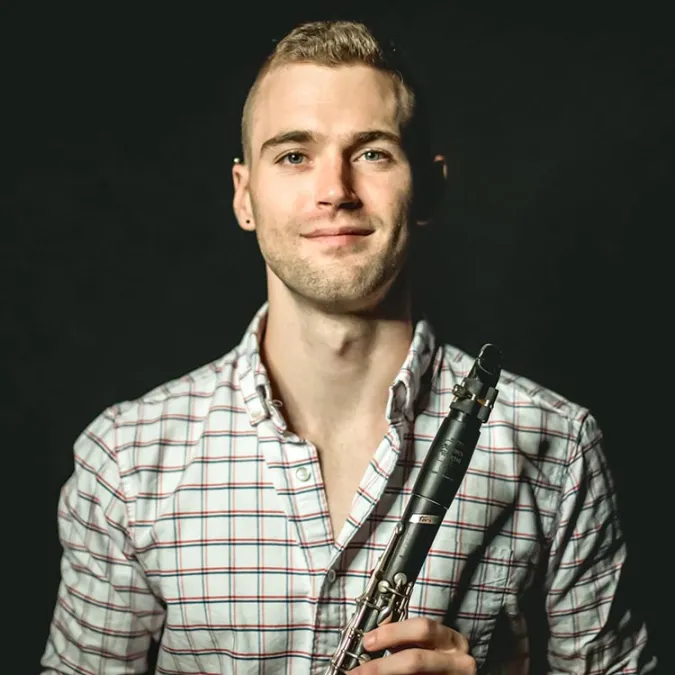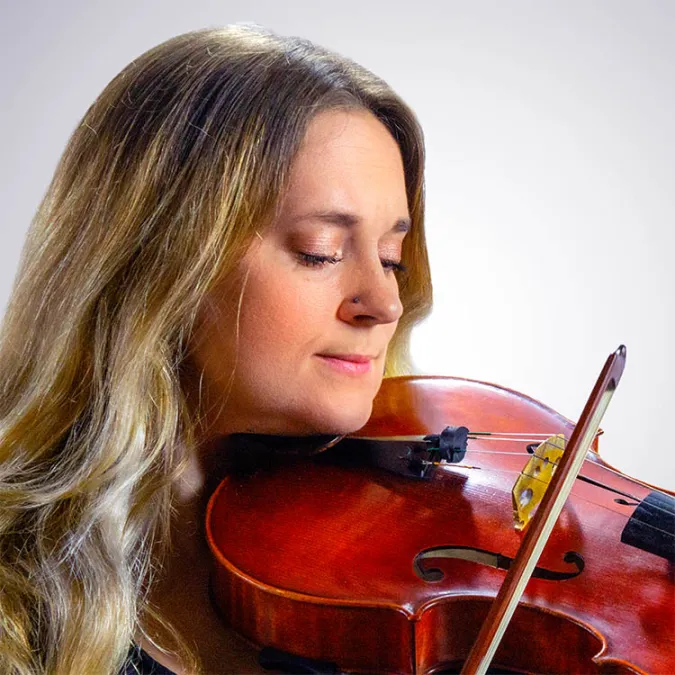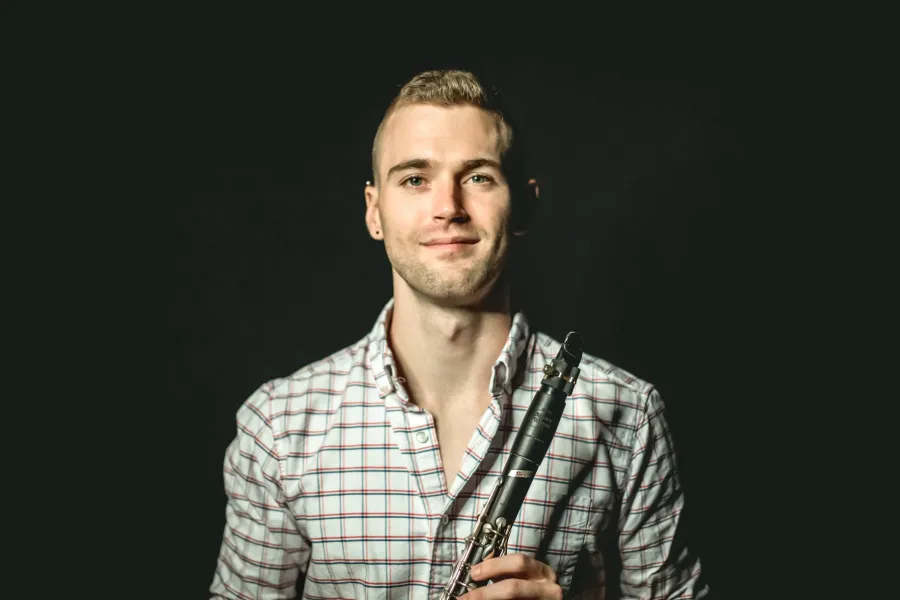Hollie Dzierzanowski, viola
SungEun Park, piano
This concert will last about 90 minutes with one intermission.
Please silence your electronic devices.
Photography, video, or recording of any part of this performance is prohibited
Program
Miriam Hyde
Legend
Tyler Webster
Story No. 4 for clarinet and piano world premiere
James M. David
Historias y Danzas
Cortazár – Axolotl
En Forma de Habañera
Un señor muy viejo con unas alas enormes – García-Márquez
En Forma de Tango (y Mambo)
intermission
Robert Schumann
Märchenerzählungen, op. 132
Lebhaft, nicht zu schnell
Lebhaft und sehr markiert
Ruhiges Tempo, mit zartem Ausdruck
Lebhaft, sehr markiert
About the Program
Program notes by Mark Bilyeu except where noted.
Miriam Hyde
Legend
Born January 15, 1913 Adelaide, South Australia
Died January 11, 2005, Sydney, Australia
Composed 1982
Duration 6 minutes
Miriam Hyde may not be a familiar name—but any chance to hear her music begs the question “why isn’t Miriam Hyde a familiar name?” Born in Adelaide Australia, she showed musical promise at a very early age, receiving scholarships to study at the Elder Conservatorium of Music in her hometown. At the age of 18, she was awarded the prestigious Elder Overseas Scholarship to attend the Royal College of Music in London, and it is there where she flourished. At the age of 21 she premiered her own piano concerto with the London Philharmonic Orchestra, and the following year she premiered her Piano Concerto No. 2 with the London Symphony Orchestra. Moving back to Australia in 1936, she continued to teach and perform while raising a family during the war. Her contributions to music education were significant, and her compositions ranged from arts songs to orchestral works, and everything in between, including her 1982 work for clarinet and piano, Legend. The work is based on a Maori myth about the creation of New Zealand's North Island. Maui, the youngest of five sons, was given a magic jawbone belonging to his grandmother. One night, with a fishhook made from this bone, he caught a huge fish. After a great struggle he hauled his catch to the surface, and it became the North Island. Listen for the clarinet cadenza, which Hyde said represented the casting of the line.
Tyler Webster
Story No. 4
Born 1989
Composed 2018/2024
World Premiere
Duration 12 minutes
Story No. 4 is part of Tyler Webster’s ongoing Story Series, a collection of works inspired by Carl Nielsen’s approach to writing his Wind Quintet, Op. 43. Nielsen composed the quintet with specific performers in mind and subsequently wrote a concerto for each member of the group, though he passed away after completing the clarinet concerto. Webster took a complementary but reversed approach: he first composed individual pieces for each member of the wind quintet ensemble LI5TEN, of which he was a member, and then created a wind quintet that wove together themes from each solo work. After completing that initial project, he continued the Story Series, composing works with friends and colleagues in mind. The original five stories were later arranged for clarinet or bass clarinet and piano, with Story No. 4 originally written for oboe and piano. Story No. 4 explores lyrical lines, rhythmic energy, and harmonic color to convey a narrative arc. The piano functions as both accompaniment and conversational partner, highlighting the character of the clarinet while interacting with its melodic themes. Performers are invited to explore phrasing, tone color, and expressive nuance, drawing out the storytelling quality of the piece. Story No. 4 exemplifies Webster’s commitment to combining contemporary idioms with melodic sensibility and narrative depth, providing a compelling addition to the modern clarinet repertoire.
– Tyler Webster
James M. David
Historias y Danzas
Born 1978
Composed 2014
Duration 15 minutes
Historias y Danzas or “Stories and Dances” is a collection of short works inspired by Latino culture for clarinet and piano. Movements I and III are inspired by short stories by two of the most prominent 20th century Spanish language writers while movements II and IV draw from traditional dance forms associated with Spain and Latin America. “Axolotl” by Julio Cortazár is a hallucinogenic work that depicts a man that becomes obsessed with the golden eyes of the small amphibians called axolotl. The clarinet and piano play swirling hard bop lines that become increasingly fixated upon a recurring rhythmic motive, which ultimately subsumes the entire texture. “En forma de Habeñera” is based on the beautiful vocalise by Ravel and features a particularly melismatic clarinet part against an uncharacteristically wavering ostinato. The title of the third movement translates to “A very old man with enormous wings,” which is among the best-known works by Gabriel García-Márquez. Here, a motive extracted from Renaissance composer Thomas Morley provides a structure that binds together all of the movements. An extremely loose sense of time and meter is pervasive and reflects the unsettling nature of the short story. Finally, “En Forma de Tango (y Mambo)” was meant to be an unfiltered homage to the great tradition of tango, but my love of mambo rhythms could not be entirely suppressed!
— James M. David
Robert Schumann
Märchenerzählungen, op. 132
Born June 8, 1810, Zwickau, Germany
Died July 29, 1856, Endenich, Bonn, Germany
Composed October, 1853
Duration 15 minutes
Robert Schumann composed the four movements of his Märchenerzählungen (Fairy-Tale Narrations) in the span of four days in October of 1853. It’s possible that Schumann intended it to be a sequel to his wildly popular Märchenbilder (Fairy-Tale Pictures) from a few years earlier, but there is no specific proof of this, other than each work contains four movements. His wife Clara wrote in her diary, “Today Robert completed 4 pieces for piano, clarinet, and viola and was very happy about it. He thinks that this compilation will appear highly romantic.” Although he did not attach specific tales to the movements, it’s easy for one to craft their own narratives to these charming works. The first is a jolly, whimsical vignette while the second movement feels more weighted and dramatic. The third is a lovely melodious song, followed by a rhythmic, resolute frolic to the end.
About the Artists
Tyler Webster

Tyler Webster, born in 1989, is a Texas-based clarinetist, composer, and educator. He serves as third and bass clarinet with the San Antonio Philharmonic and as associate principal and Eb clarinet with both the West Texas Symphony and Abilene Philharmonic. He also performs regularly with the New Mexico Philharmonic and other orchestras across central Texas. Academically, Tyler acts as lecturer in clarinet at The University of Texas at Austin and the University of the Incarnate Word, and as assistant professor of clarinet and general music at Texas Lutheran University, where he developed a project-based music technology course giving students hands-on experience with notation software, recording, and multimedia skills. He maintains an active private studio in the northern San Antonio metroplex. Tyler earned his Doctor of Musical Arts and Artist Diploma from The University of Texas at Austin, his Master of Music from Northwestern University, and his Bachelor of Music from Texas Tech University. Performing and writing music since the age of ten and making his professional composing debut at seventeen, he has spent over twenty years creating works for solo instruments, chamber groups, and large ensembles. His compositions include the Story Series for solo instruments, with Story No. 7 and the clarinet choir work Visions premiered at the 2025 International Clarinet Association convention, and Impulsive Fragments premiered at the 2024 Texas Music Educators Association convention. Tyler’s career reflects a dedication to expanding the clarinet repertoire while fostering musical artistry, collaboration, and innovative pedagogy.
Hollie Dzierzanowski

Dr. Hollie Dzierzanowski is a classically trained violist with a Doctor of Musical Arts in viola performance from the University of North Texas, where she studied with Dr. Susan Dubois. Her doctoral research, mentored by Dr. Kris Chesky, is the largest study to date on viola-specific occupational health and the first to explore the biopsychosocial effects of viola jokes. Based in the Dallas–Fort Worth area, Hollie performs regularly and teaches at East Texas A&M University and Dallas College. She is also a section violist with the Abilene Philharmonic. She earned both bachelor’s and master’s degrees in viola performance from the Cleveland Institute of Music, studying with Stanley Konopka and Mark Jackobs. Hollie is dedicated to musician health and injury prevention. A Licensed Body Mapping Educator and Training Mentor with the Association for Body Mapping Education (ABME), she serves on its Board of Directors, Social Media team, and as co-chair of the research committee. She co-authored the upcoming Oxford Handbook of Musician Health Advocacy and was program manager for the 2025 First Global Summit on Occupational Health in Music. She also holds certifications in Dalcroze, ELDOA, Suzuki, and Pilates.
SungEun Park

SungEun Park is a distinguished pianist and educator who has performed extensively across Korea, Europe, and the United States as both a soloist and chamber musician. She serves as assistant professor and director of piano studies at Texas Lutheran University, program director of the Texas State International Piano Festival, and is a piano faculty member at the Austin Chamber Music Center. A winner of numerous awards, including the 5th TSIPF Concerto Competition, the American Prize, and the Seoul Asia International Music Competition, Dr. Park has appeared as concerto soloist with the Central Texas Philharmonic Orchestra, the University of Texas Symphony Orchestra, the Balcones Community Orchestra, and the Jeju Philharmonic Orchestra. An advocate for contemporary music, she frequently premieres works by leading composers and has been featured as a guest artist at the Hawaii International Conference on Arts & Humanities, the National Association of Composers, the Composers Alliance of San Antonio, and the One Month Festival. Her expertise extends to adjudicating competitions such as the Texas Young Artist Piano Competition, the Rose Petroff Piano Competition, and the TFMC All State Festival. Holding a DMA from The University of Texas at Austin and an M.M. from Texas State University, Dr. Park continues to inspire audiences and students worldwide.
Upcoming Events
Symphony Orchestra
Friday, September 19, 7:30 p.m.
Bates Recital Hall
Wind Ensemble
Featuring Jonathan Gunn, clarinet
Sunday, September 21, 4 p.m.
Bates Recital Hall
New Musical Ensemble
Monday, September 22, 7:30 p.m.
Bates Recital Hall
Anton Nel, piano
Monday, September 29, 7:30 p.m.
Bates Recital Hall
Event Details
$10 – 20
All University of Texas at Austin students are allowed one free ticket as long as they are available. Student tickets must be picked up at the Box Office with valid student I.D. Seating is unassigned.
If you are a patron with specific seating needs, please email tickets@mail.music.utexas.edu and we will reserve ADA seating for you.


